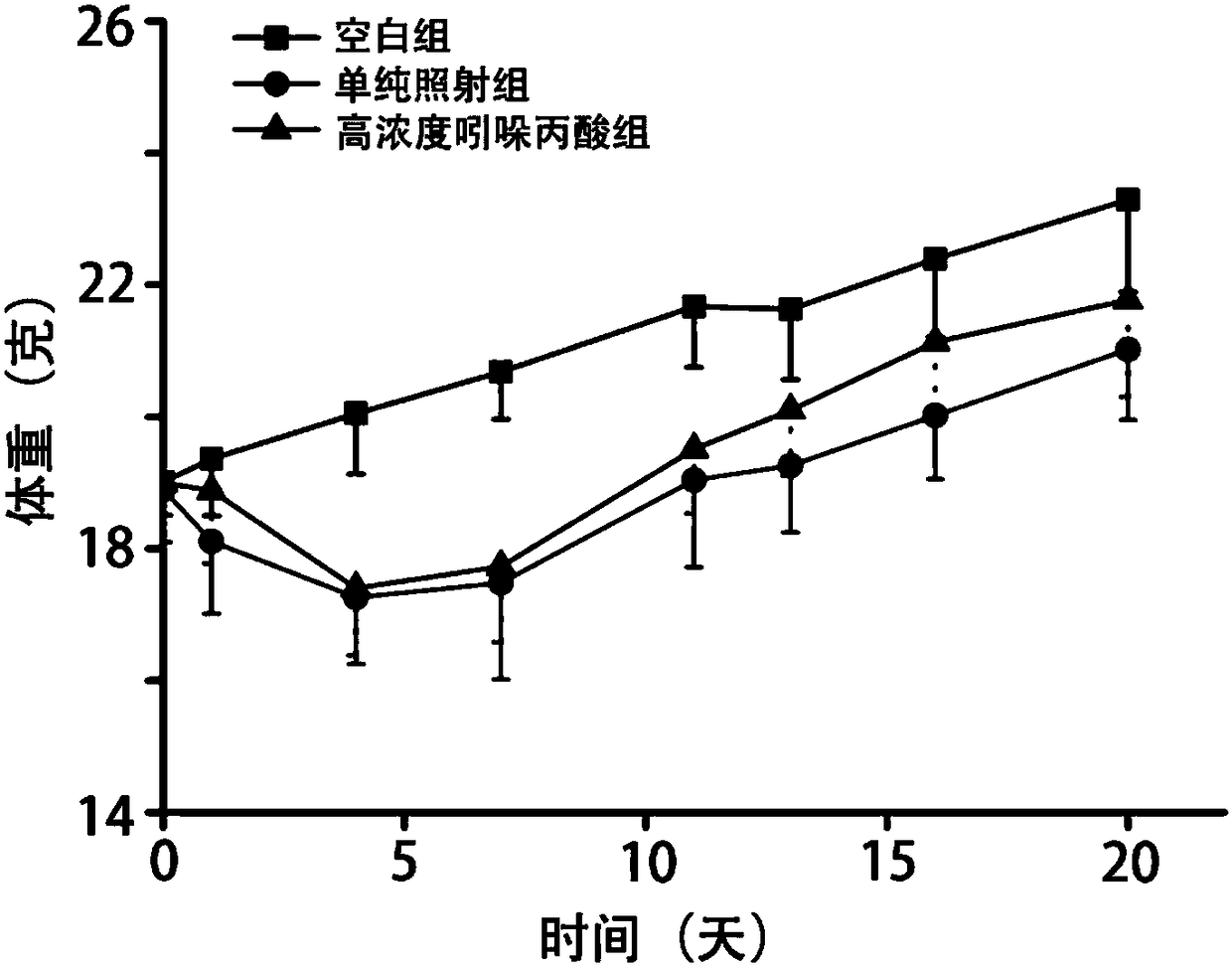Application of indolepopionic acid to preparation of drugs for preventing and/or treating tumor radiotherapy side effect
A technology of tumor radiotherapy and indole propionic acid, which is applied in the field of medicine, can solve the problems of no protective effect, short duration of amifostine's drug effect, and the restriction of wide application in the course of rejection surgery
- Summary
- Abstract
- Description
- Claims
- Application Information
AI Technical Summary
Problems solved by technology
Method used
Image
Examples
Embodiment 1
[0053] Example 1: Survival rate of mice after whole-body irradiation with γ-rays and weight detection after partial abdominal irradiation with γ-rays.
[0054] 1. Experimental animals:
[0055] C57BL / 6J mice, 6-8 weeks old, weighing about 20g, male, were randomly divided into three groups: irradiation group, low concentration indole propionic acid group and high concentration indole propionic acid group, 30 mice in each group.
[0056] 2. Model establishment:
[0057] After adopting 0.3% chloral hydrate to anesthetize experimental mouse (anesthetic dose is 1ml / g), use 40Exactor carried out local irradiation of γ-ray abdomen on the whole abdomen of mice ( 40Exactor comes with a partial irradiation mold, the entire abdomen is fully exposed), the absorbed dose is 15Gy, and the dose rate is 1Gy / min.
[0058] 3. Administration method:
[0059] Indole propionic acid group: start administration 24 hours before irradiation, administration method: intragastric administration of i...
Embodiment 2
[0066] Example 2: Detection of intestinal goblet cells in mice after abdominal local irradiation with γ-rays.
[0067] 1. Experimental animals:
[0068] C57BL / 6J mice, 6-8 weeks old, weighing about 20g, male, were randomly divided into three groups: blank group, simple irradiation group and indole propionic acid group, 30 mice in each group.
[0069] 2. Model establishment:
[0070] After adopting 0.3% chloral hydrate to anesthetize experimental mouse (anesthetic dose is 1ml / g), use 40Exactor carried out local irradiation of γ-ray abdomen on the whole abdomen of mice ( 40Exactor comes with a partial irradiation mold, the entire abdomen is fully exposed), the absorbed dose is 15Gy, and the dose rate is 1Gy / min.
[0071] 3. Administration method:
[0072] Indole propionic acid group: start administration 24 hours before irradiation, administration method: intragastric administration of indole propionic acid liquid, once a day at 2 pm, continuous administration for 10 days;...
Embodiment 3
[0080] Example 3: Detection of colon length in mice after localized abdominal irradiation with γ-rays.
[0081] 1. Experimental animals:
[0082] C57BL / 6J mice, 6-8 weeks old, weighing about 20g, male, were randomly divided into three groups: blank group, simple irradiation group and indole propionic acid group, 30 mice in each group.
[0083] 2. Model establishment:
[0084] After adopting 0.3% chloral hydrate to anesthetize experimental mouse (anesthetic dose is 1ml / g), use 40Exactor carried out local irradiation of γ-ray abdomen on the whole abdomen of mice ( 40Exactor comes with a partial irradiation mold, the entire abdomen is fully exposed), the absorbed dose is 15Gy, and the dose rate is 1Gy / min.
[0085] 3. Administration method:
[0086] Indole propionic acid group: start administration 24 hours before irradiation, administration method: intragastric administration of indole propionic acid liquid, once a day at 2 pm, continuous administration for 10 days; dosage...
PUM
| Property | Measurement | Unit |
|---|---|---|
| Concentration | aaaaa | aaaaa |
| Concentration | aaaaa | aaaaa |
Abstract
Description
Claims
Application Information
 Login to View More
Login to View More - R&D
- Intellectual Property
- Life Sciences
- Materials
- Tech Scout
- Unparalleled Data Quality
- Higher Quality Content
- 60% Fewer Hallucinations
Browse by: Latest US Patents, China's latest patents, Technical Efficacy Thesaurus, Application Domain, Technology Topic, Popular Technical Reports.
© 2025 PatSnap. All rights reserved.Legal|Privacy policy|Modern Slavery Act Transparency Statement|Sitemap|About US| Contact US: help@patsnap.com



